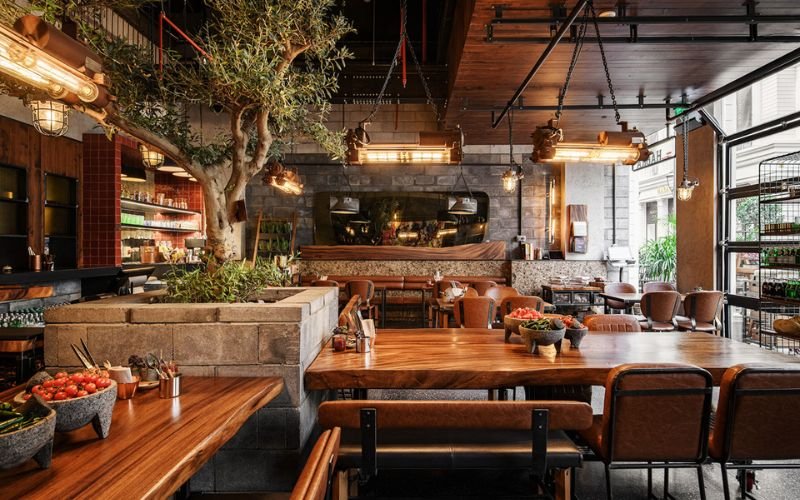Introduction & Concept Overview
The Rise of Container Coffee Shops
Shipping container coffee shops blend eco-friendly design with practical use. These creative spaces turn old shipping containers into fully working coffee shops, bringing new life to unused metal boxes and giving business owners a fresh way to serve customers in style.
Container cafes have taken off as cities grow bigger and people care more about being green. The setup costs less than a regular building, and owners can easily move their shop to different places like busy streets, events, or even far-off spots where there’s not much around.
These unique coffee shops create spaces that customers love to visit. Moving shipping containers from place to place makes it easy to follow where business is best, whether it’s summer or winter.
What started as a clever way to use extra containers has grown into something much bigger. Now these shops come with heating, proper walls, and all the things you’d expect in a regular cafe, as shown by Shipping Container Café. Modern container cafes are both safe and stylish, keeping workers and customers comfortable while looking cool.
Using old containers for new coffee shops helps save resources and shows how creative thinking can make business better. This smart idea keeps growing more popular as more people want their businesses to be both successful and good for the environment.
Designing the Layout & Functionality
Creating an efficient layout for a shipping container coffee shop requires careful planning. Every square inch of space must be used wisely in these small buildings. Good planning helps workers move easily and makes customers feel welcome in the tight space.
The first step is marking different zones for service, prep work, seating, and storage. Well-thought-out spaces help workers serve customers quickly during busy times, especially when many people want their morning coffee. Placing equipment like espresso machines near the counter helps baristas work faster.
Making the shop look good means mixing industrial container parts with cozy touches. Simple colors work best for the base design, with bright spots of color added to match your brand. The right mix of metal walls and warm wood can create a space that feels both modern and comfortable.
Key Layout Elements
| Zone | Purpose | Design Tip |
|---|---|---|
| Service Counter | Customer interaction and point of sale | Place near entrance with clear visibility |
| Beverage Prep Area | Espresso machine, grinder, and tiling | Optimize workflow by clustering equipment |
| Seating Zone | Customer relaxation and socializing | Utilize flexible furniture to accommodate groups |
| Storage & Utility | Supplies and waste management | Integrate hidden storage to maintain a clean look |
Smart furniture choices can make your shop more useful. A counter that folds away or seats that can be moved around help you change the space when needed throughout the day.
Light plays a big role in making the shop work well. Mix bright work lights over the counter with softer lighting in seating areas to create the right mood. Using LED lights helps save power and shows customers you care about the environment.
The best container coffee shops balance good service with a welcoming feel. Getting the layout right takes time, but it’s worth the effort to create a space customers will remember and want to visit again.
Container Coffee Shop Construction
Planning & Basic Steps
Converting a shipping container into a coffee shop takes careful planning. The whole process starts with picking good containers that will last long. These special boxes need to meet safety rules and be strong enough for daily business use.
A step-by-step approach makes the conversion process much easier. Finding containers that won’t rust quickly saves money in the future and helps the shop run better over time.
Here are the main parts of turning a container into a coffee shop:
Key Stages
Materials & Structure
Look over the container carefully for any damage. A quick check will show if there are dents or rust spots that need fixing. The container needs good insulation and weather protection to keep energy bills low.
Safety Rules
Following building codes is very important. Every project needs proper wiring and good air flow. We always get experts to check our work at different stages to make sure everything is safe.
Making Changes
Cut holes for windows and doors with great care. The container must stay strong even with these openings. Make a good plan for where everything will go – the coffee machines, storage, and customer seating. Good heating and cooling systems are really important.
Smart Tips
Use recycled materials when you can. Old wood can look great inside and help the environment. Building with containers often costs less than regular buildings – sometimes saving up to 40%.
For more ideas about container coffee shops, check out the Container Coffee Bar page. With good planning and the right materials, your container coffee shop can be both unique and successful.
4. Benefits, Cost-Effectiveness & Environmental Impact
Key Advantages
Shipping container coffee shops offer unique benefits compared to regular cafes. These portable units can be moved anywhere with ease. Business owners can test different locations without signing long leases to find the best spot. Moving a container coffee shop to busy areas or special events helps make more money.
Cost savings make container coffee shops very attractive. The simple design means building costs are much lower than regular cafes. Owners find it easier to plan their budgets because container builds have fewer surprise expenses. Small business owners with limited money can start their dream cafe much faster.
Going green is another big plus for container coffee shops. Using old shipping containers helps save resources and cut waste. Container cafes are built to last and don’t need much fixing over time. Smart features like good insulation and solar panels help these shops use less energy.
We’ve helped many people turn containers into coffee shops. The short setup time lets owners start making money faster than with regular cafes. These projects show that container cafes can save both money and energy year after year. For more details about these benefits, check out Benefits of Shipping Container Cafés. Container coffee shops are perfect for business owners who want to save money while helping the environment.
5. Real-life Case Studies & Unique Innovations
A shipping container coffee shop needs both good design and practical function to be successful. The team showed this perfectly when they turned a 10-foot container into a stylish coffee shop that could move between different events.
Design Challenges and Solutions
Getting the most out of small spaces was a big challenge. Our team created a beautiful space with pull-out counters and fold-up seats that worked well for both servers and customers to move around. The coffee shop became more than just a place to get drinks – it turned into a small community spot where local artists could show their work on custom shelves under special lighting.
The cold metal box transformed into a warm, welcoming space that city workers and artists both loved. Another project we did used two containers side by side on a busy walkway, creating separate areas for making coffee and customer seating. Smart design choices, like a shared outdoor area and sliding glass walls, helped connect the two containers and let in plenty of sunlight.
Being able to change the space easily is what makes container coffee shops work so well. A coffee shop can switch from serving morning coffee to hosting evening music shows just by moving some furniture around. These real examples show how limited space can inspire creative design.
Each successful project proves that being eco-friendly and creative can work together perfectly. Pictures of designs and before-and-after photos help other business owners see what’s possible with shipping container coffee shops.
6. Maintenance, Relocation & Future Trends
Taking good care of your shipping container coffee shop is key to its success. Regular checks include looking at welds, seals, and air conditioning units to make sure everything works properly throughout the year. This attention to detail helps prevent costly breakdowns and keeps the business running smoothly day after day.
Regular Maintenance Tasks
Smart design makes repairs easier. Basic maintenance tasks include:
• Check structure every 6 months
• Clean windows and vents weekly
• Fix electrical and plumbing issues promptly
• Service air conditioning regularly
Container coffee shops can move when needed, unlike regular buildings. Their unique design lets owners take them to festivals, markets, or busier locations with minimum hassle, though proper planning and permits are necessary. Moving the container requires careful thought about equipment and timing, but the process is straightforward when planned well.
Looking to the future, these shops are becoming more eco-friendly and high-tech. Simple changes like better building materials and energy-saving equipment help cut costs over time. Modern container cafes now often include solar panels, digital payment options, and ways to track orders automatically through their systems. Learn more expert tips at: Start Your Own Container Café.
Good maintenance and the ability to move locations help these businesses stay successful. By staying current with trends and technology, container coffee shops can keep growing and changing to meet customer needs.
FAQs
How much does it cost to convert a shipping container into a coffee shop?
The conversion cost typically ranges from $20,000 to $50,000, depending on design complexity and required equipment.
Do shipping container coffee shops need special permits?
Yes, they require standard food service permits, building permits, and sometimes special mobile business licenses.
How long does it take to convert a shipping container into a coffee shop?
The conversion process usually takes 4-8 weeks, depending on customization and local regulations.
Can shipping container coffee shops operate year-round?
Yes, with proper insulation and HVAC systems, container coffee shops can operate comfortably in all seasons.
What are the main advantages of a container coffee shop over traditional cafes?
Container coffee shops offer lower startup costs, mobility, eco-friendliness, and faster setup time compared to traditional cafes.





